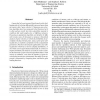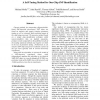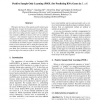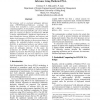CSB
2004
IEEE
14 years 3 months ago
2004
IEEE
CSB
2004
IEEE
14 years 3 months ago
2004
IEEE
There is considerable interest in computational methods to assist in the use of genetic polymorphism data for locating disease-related genes. Haplotypes, contiguous sets of correl...
CSB
2004
IEEE
14 years 3 months ago
2004
IEEE
Motivation: Cell-cycle regulated gene prediction using microarray time-course measurements of the mRNA expression levels of genes has been used by several researchers. The popular...
CSB
2004
IEEE
14 years 3 months ago
2004
IEEE
A great deal of recent research has focused on the challenging task of selecting differentially expressed genes from microarray data (`gene selection'). Numerous gene selecti...
CSB
2004
IEEE
14 years 3 months ago
2004
IEEE
Current methods for interpreting oligonucleotidebased SNP-detection microarrays, SNP chips, are based on statistics and require extensive parameter tuning as well as extremely hig...
CSB
2004
IEEE
14 years 3 months ago
2004
IEEE
RNA genes lack most of the signals used for protein gene identification. A major shortcoming of previous discriminative methods to distinguish functional RNA (fRNA) genes from oth...
CSB
2004
IEEE
14 years 3 months ago
2004
IEEE
Motivation: Since the whole genome sequences for many species are currently available, computational predictions of RNA secondary structures and computational identifications of t...
CSB
2004
IEEE
14 years 3 months ago
2004
IEEE
Phylogenetic trees are commonly reconstructed based on hard optimization problems such as maximum parsimony (MP) and maximum likelihood (ML). Conventional MP heuristics for produc...
CSB
2004
IEEE
14 years 3 months ago
2004
IEEE
In theory, it should be possible to infer realistic genetic networks from time series microarray data. In practice, however, network discovery has proved problematic. The three ma...
CSB
2004
IEEE
14 years 3 months ago
2004
IEEE
Our previous work to accelerate phylogeny inference using HW/SW(Hardware/Software) co-design has recently been extended to a more powerful embedded computing platform. In this pla...





